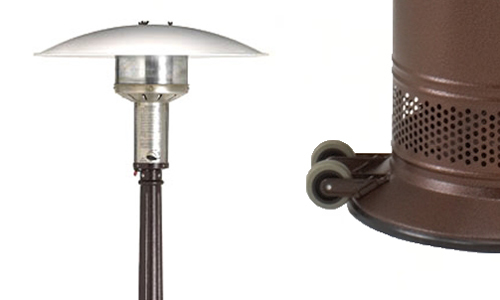8-minute read
|
Heaters
While it might sound like a waste of time and money to heat outdoor areas that aren’t fully enclosed or airtight, it’s actually quite doable. Outdoor portable heaters provide an excellent way to add warmth to outdoor spaces, and thanks to recent advancements in technology and design, these heaters can also double as stylish decorative pieces. Whether you’re looking to add a cozy glow to a dim outdoor area or enhance the ambiance of an enclosed patio, there’s a portable heater available in every shape and size to meet your heating needs. Read on for essential tips on selecting the perfect portable heater, understanding how much space it can cover, and choosing one that fits both your design and heating preferences. There are numerous types of portable outdoor heaters. It’s crucial to understand the differences between them to ensure you make a smart purchase. The two most common types of portable patio heaters are: Both types share many benefits, but each also offers unique advantages. Keep reading to learn more about these heaters and use the insights to pick one that best suits your requirements. A portable propane patio heater is typically easy to move around, provided you have a wheel kit to roll it on. The main reason such heaters are considered portable is that they rely on a propane tank for fuel. When buying a portable patio mushroom heater, you can effectively warm up a space using infrared heat that disperses in a 360-degree circular pattern. When a portable patio heater stops generating heat, it usually indicates that it has run out of propane. Luckily, swapping out empty propane tanks is straightforward. Simply replace the empty tank with a full one, either by getting it refilled at most grocery stores or gas stations, or by purchasing pre-filled tanks. A commercial portable patio heater is usually bought to keep customers or staff warm in large outdoor seating areas. For instance, many restaurants with outdoor patios install commercial portable heaters to provide some warmth, allowing them to keep their outdoor seating open even during colder months. One of the key reasons businesses, such as restaurants and bars, opt for outdoor propane heaters is that they don’t need natural gas hookups, giving them the flexibility to place heaters wherever necessary. Breweries operate similarly, often using commercial outdoor propane heaters to keep patrons warm during cooler periods. Hotels, community centers, and apartment complexes offering outdoor seating areas also frequently use these heaters to provide comfort to their guests and residents. With a residential portable patio heater, you can comfortably warm up almost any outdoor area. From screened-in porches to open garages and uncovered patios, the right heater ensures you, your family, and your guests stay comfortable outdoors all year round. Even during snowy weather, the right heater lets you enjoy the outdoors. This means you and your loved ones can savor outdoor meals, sip morning coffee al fresco, and even stargaze through a telescope in your backyard without freezing. BTU stands for British thermal unit. It’s a measurement used to quantify the heat energy produced by various fuels. More scientifically, BTU refers to the amount of energy required to raise the temperature of one pound of water by one degree Fahrenheit (at sea level). When evaluating a heater’s performance, always check its BTU rating. Higher BTUs generally indicate better heating capabilities. However, it’s wise to avoid purchasing a heater with excessive power for a small space, as this improves safety and boosts efficiency. Here’s a guide to help you determine the appropriate number of BTUs for different outdoor space sizes: When searching for a heater that matches your aesthetic preferences, you’ll find plenty of options. Some of the most popular outdoor patio heaters come in the following styles: Need more details? Got questions? Get in touch with us today, and we’ll be happy to assist! Bearing RUIAN SHUNCHENG TRADING CO.,LTD , https://www.sunchevmarine.comUser Guide for Shopping for Outdoor Portable Heaters

Are There Different Types of Portable Heaters?
What Is the Purpose of Portable Propane Patio Heaters?
Who Needs to Use a Commercial Portable Patio Heater?
What Are the Benefits of Residential Propane Heaters?
How to Determine BTU Power For an Outdoor Space?
What Are the Different Styles of Outdoor Patio Heaters?
```html
Go Back To Blog
Bearing